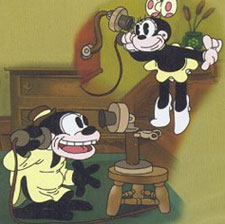 Bosko cartoons were among the "Looney Tunes" group by Hugh HarmAn & Rudy Ising, who had formerly worked for Walt Disney on the "Alice Comedies" & share some of the stylistic content of those silent cartoons.
Bosko cartoons were among the "Looney Tunes" group by Hugh HarmAn & Rudy Ising, who had formerly worked for Walt Disney on the "Alice Comedies" & share some of the stylistic content of those silent cartoons.
As "Tunes" instead of 'Toons, these always had musical soundtracks, but minimal dialogue because words were harder to match up to animated mouth movements with the technology of the day. Characters were more apt to sing than speak, since the musical "beat" made it easier to match up mouth movements to lyrics than to mere sentences. Bosko's "sentences" tended to be one, two, or three words, & the mouth movements very exaggerated with the mouth expanding in size.
It was a while before audiences took "talking" in films for granted, & the exaggerations were in great part because the mere fact that animated characters could speak at all was in & of itself terribly novel. The novelty was so large, in fact, that generally nobody thought it was necessary to also tell a story. A non-stop soundscape of music, with occasional shouted words, was all the audience required to be impressed.
Many animal-characters of the period were drawn, in black & white, as being predominantly black with large white eyes, including Foxy & his successor Mickey Mouse, & Betty Boop's Jewish dog-pal Bimbo. When Harmon/Ising came up Bosko, it was esssentially Foxy without the fox ears, but with a small bowler hat.
He's basically a "blackface" caricature of a young black man with boyish qualities, or perhaps he's a boy with adult qualities. When re-designed for the "Little Ol' Bosko" or "Li'l Old Bosko" cartoons a few years later, he was definitively a stereotyped negro child, but initially he was, like Foxy or Mickey, simultaneously a child & an adult. And most of his scrapes were the same as would apply to Foxy or Mickey or Bosko, rather than akin to other blackface cartoon figures in early animation.
Compared to the race stereotypes of many cartoons of the era, Bosko wasn't so bad, since he was more or less interchangeable with Foxy & possessed very few race connotations beyond the bowler hat & love of music. He almost always revealed himself skillful iin both the arts, especially music, & in the work-world where he works at sundry skilled laborers from construction work to farming or lumberjack or any number of occupations.
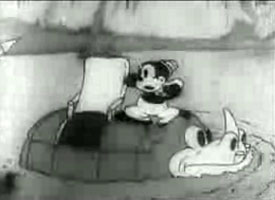 In Bosko Shipwrecked! (1931) we open on the image of a sailing ship in a storm, lightning in the heavens. Bosko is the navigator at the helm. The captain is an old bearded guy on the fo'castle. Both he & Bosko are put through minor indignities by the winds, while the captain screams & Bosko tries to keep hold of the wheel. In Bosko Shipwrecked! (1931) we open on the image of a sailing ship in a storm, lightning in the heavens. Bosko is the navigator at the helm. The captain is an old bearded guy on the fo'castle. Both he & Bosko are put through minor indignities by the winds, while the captain screams & Bosko tries to keep hold of the wheel.
But the ship's lost & Bosko washed ashore. As he lies sleeping or unconscious at the top of the tide, two monkeys come out of the forest & swipe his bowler hat. When he comes to, his hat is missing, but he gets it back very quickly, we're not shown how.
There's a lion on the island which chases Bosko. He tricks the lion into being eaten by a crocodile, has a couple more scary adventures, then encounters the bone-through-the-hair cannibal tribe. A skeleton looks out from the cooking cauldron & frightens Bosko. The king of the tribe seems to have the ape from Jungle Jazz as his guard or companion.
This is the kind of stereotyped tribe that makes so many old cartoons so damnably offensive. The strange thing is that Bosko himself is "just" a kid, if not a tiny adult, who has few of the "traits" of blackface negro figures seen in movies & animations of this era. And yet this seemingly progressive attitude toward a black character doesn't extend to negro tribal peoples, who are barely distinguishable from the gorilla in their midst.
Bosko threatens the king with a harmless pop-gun then runs off with the whole ugly-ass tribe in pursuit. He runs to the water's edge & jumps in a boat that turns out to be the wide open mouth of a creature part hippo & part rhino. Bosko opens the "hatch" of the plated animals back, rides him away to safety, rilpping off the creature's horn to blow a raspberry at the tribe.
There are many points in this animation that obviously called for specific sounds. Only a few of them have appropriate sound at the appropriate time, suggesting this is a secondary soundtrack rather than the original.
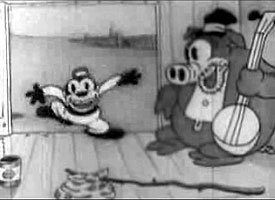 A train is barrelling down the tracks. For Box Car Blues (1930) we're brought immediately into the realm of "speeding train gags" which every cartoon character of the era went through.
A train is barrelling down the tracks. For Box Car Blues (1930) we're brought immediately into the realm of "speeding train gags" which every cartoon character of the era went through.
Bosko & his travelling companion, a tramp hog, are riding the rails, in an episode remiscent of a couple Oswald the Lucky Rabbit cartoons when he & Pegleg Pete play hobos. Bosko is dancing for his piggy pal, who has a banjo. They begin to do a bit of southern blues together.
On a steep hill, Bosko & the hog's traincar breaks loose & they're on a runaway train. Bosko climbs on the roof of the boxcar yelling "Help! Help!" Sight gags typical of the era's animated runaway trains or trolleys proceed one after another, nothing especially imaginative.
There's a tree growing at the end of the tracks & the boxcar crashes into pieces, but Bosko & the hog are all right & able to finish the little song.
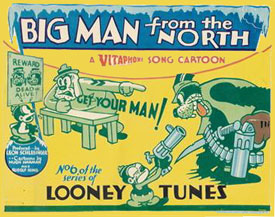 If Bosko was in general viewed by theater aukdiences of the day as a black boy, he would've been rather progressive of type, as he can be anything from navigator of a ship at sea to a Canadian mountie, having no racial barriers to get across in order to pursue any occupation he desires. If Bosko was in general viewed by theater aukdiences of the day as a black boy, he would've been rather progressive of type, as he can be anything from navigator of a ship at sea to a Canadian mountie, having no racial barriers to get across in order to pursue any occupation he desires.
In A Big Man from the North (1930), a white hounde with a lawman's badge lives in a mountie's cabin in the snowy wilderness.
There's a knock at the door & when the hound opens it, Bosko in his trousers, bowler, & lawman's badge, is blown into the room.
Bosko is ordered to go & capture, dead or alive, a frightening villain. He sets out with two mushing dogs & a mushing puppy across the stormy snow covered landscape, with suitable gags along the route.
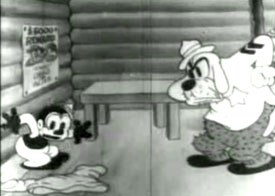 Arriving at a saloon, Bosko shines his badge & enters with guns drawn, but nothing untoward justified the guns, & he's soon quite taken with his female counterpart, Honey, who is standing on a table singing & dancing for the patrons. Her "yatta totty tah tah" song sounds very Betty Boopish. The patrons are dog-people. Arriving at a saloon, Bosko shines his badge & enters with guns drawn, but nothing untoward justified the guns, & he's soon quite taken with his female counterpart, Honey, who is standing on a table singing & dancing for the patrons. Her "yatta totty tah tah" song sounds very Betty Boopish. The patrons are dog-people.
Bosko leaps up the table & plays mouth-horn beside Honey. Patrons clap, the dog people & the beavers who slap their tails together.
Bosko's in a show-off mood & plays a Klondike rag on the upright piano & scats "Yoopy doopy doo," until taht big scary pegleg bad guy shows up, behaving frightfully.
Though Bosko behaves bravely, the thuggish giant only laughs at him, & Bosko's gun is only a pop-gun with a cork that springs out. In the fight that follows, Bosko actually gets his hands on a sabre, pulls down the thug's trousers, & sticks the sword up his arse. The bad guy runs away rather than gets captured, but the patrons are impressed with Bosko.
The first half of this script was recycled from the Oswald the Lucky Rabbit cartoon Ozzie of the Mounties (1928).
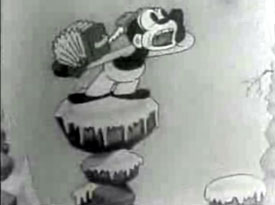 In Yodeling Yokels (1931) Bosko leaps from rocky tower to rocky tower in a stony wilderness, playling his concertina & crying out "Yodel ay-dee-hoo" & hearing an echo's reply.
In Yodeling Yokels (1931) Bosko leaps from rocky tower to rocky tower in a stony wilderness, playling his concertina & crying out "Yodel ay-dee-hoo" & hearing an echo's reply.
Baby bears play leapfrog &am pbark. A family of mountain sheep leap & bound through the alps. Bosko gets a rasperry from an owl who dislikes his yodelling, so Bosko shoots the poor critter's feathers off.
He finds Honey living in what appears to be a big mail box on a post. She runs down the crooked stairs to the ground to meet Bosko, answering his yodels with her own until they're face to face with their goofy music & a lot of so-so gags, including rolling down a hill in a big snowball & whatnot.
Meanwhile in her house a mouse, finding the mistress away, begins to explore the house. He plays a game of golf using a pea for a golfball, trying to get it into the hole of a piece of swish cheese. He's a lousy golfer & gets increasingly frustrated.
Honey falls off the cliff onto a slab of ice rapidly carried away on the river. Bosko gets the St. Bernard dog & they take off intent on saving her. "Help! Save me!" They do so, just before she goes over a cliff, & the St Bernard's puppy shows up. Back home the mouse finally got the pea in the hole, so it's a happy ending for all.
copyright © by Paghat the Ratgirl
|
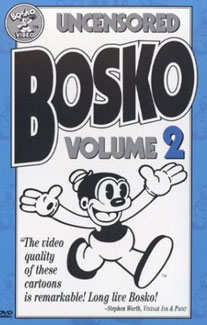




 Arriving at a saloon, Bosko shines his badge & enters with guns drawn, but nothing untoward justified the guns, & he's soon quite taken with his female counterpart, Honey, who is standing on a table singing & dancing for the patrons. Her "yatta totty tah tah" song sounds very Betty Boopish. The patrons are dog-people.
Arriving at a saloon, Bosko shines his badge & enters with guns drawn, but nothing untoward justified the guns, & he's soon quite taken with his female counterpart, Honey, who is standing on a table singing & dancing for the patrons. Her "yatta totty tah tah" song sounds very Betty Boopish. The patrons are dog-people.